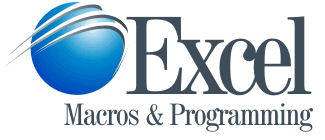
Excel Macros Section 2: VBA (Macros) Vocabulary
By Pierre Leclerc.
In the first section you have discovered the Visual Basic Editor and the Macro Recorder. You have learned how to communicate with Excel and how to test your VBA procedures (Macros).
In this second section you will discover the programming language itself: VBA or Visual Basic for Application. You will learn the vocabulary to ask anything from Excel. After section 2 you will be able to develop small and useful macros and even very complex programs.
Lesson 11: VBA Coding Tips and General Vocabulary
Lesson 12: Working with Errors
Lesson 13: Working with the Application
Lesson 14: Working with Workbooks
Lesson 15: Working with Worksheets
Lesson 16: Ranges, Cells, Rows and Columns
Lesson 17: Message Boxes in VBA for Excel
Lesson 18: Excel VBA Vocabulary to Filter and Sort Data
Lesson 19: Working with Variables
Lesson 20: Working with Statements
Lesson 21: Working with Functions
Lesson 22: Working with SQL and External Data
Lesson 23: Working with other programs in VBA for Excel
This website is divided in three sections:
Section 1: Excel Macros Programming: Lessons 1 to 10
This section is about recording, writing, modifying and testing macros in the Visual Basic Editor. You will also learn about security and discover "events" (an event is what starts the macro).
Section 2: Excel VBA Vocabulary: Lessons 11 to 23
Developing a macro is communicating with Excel and to do so you need to use a language called Visual Basic for Applications (VBA). In section 2 you will learn all the VBA vocabulary that is essential to work with business data (accounting, sales, production and others).
Section 3: Forms and Controls in VBA for Excel: Lessons 24 to 33
The userform is a small or large dialog window that you create and allows the user to submit values that will be used by your macros. To these userforms you will add controls (command buttons, text boxes, list boxes and others) and program them.
 Back home
Back home